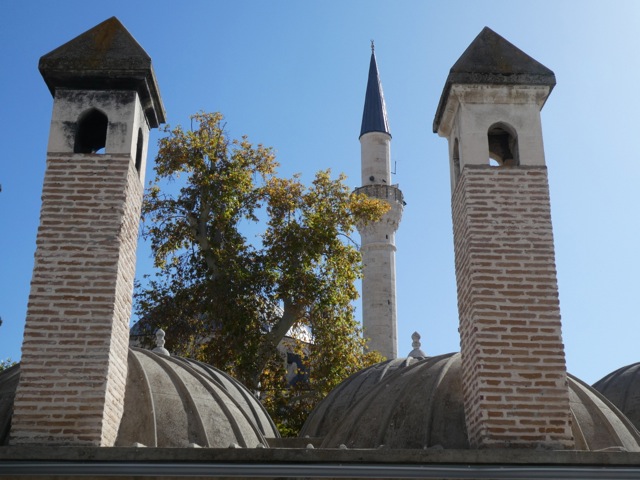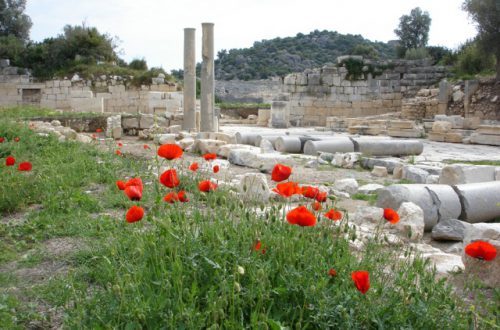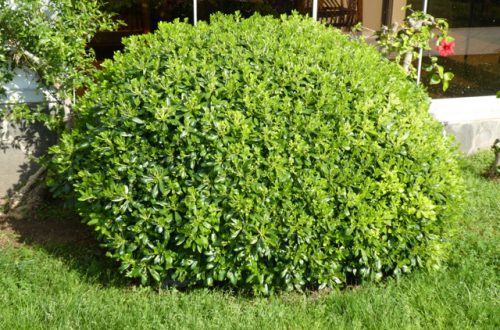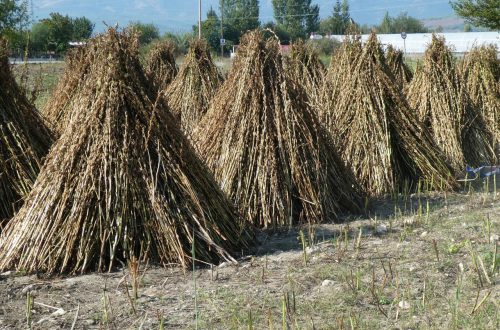
Elmali – A Town Of Mountains And Apples
Photographs by Mike Vickers
Feature photo above: The chimneys of the medrese with the Ömer Paşa Camii minaret beyond
Elmali is well worth that little bit of extra effort to visit. Nestling high in the mountains beyond Seki and about 110km from Fethiye, this lovely town sits at the head of an upland valley that is expansive, well-watered, fertile – and absolutely perfect for growing apples. Lots of apples. This one valley supplies about 12% of all the apples grown in Turkey, proudly ranked as the fourth largest producer of apples in the world with a national harvest of just over three million tonnes in 2017. A simple calculation makes Elmali’s contribution in the region of 360,000 tonnes – and that’s definitely a full evening of apple bobbin’ at Halloween! Indeed, this ancient association with apples has given the town its name – the Turkish word for apple is elma.
Getting to Elmali from Fethiye is in itself a delightful journey. Beyond Seydikemer, the main D350 road to Antalya rises for kilometres to the Karabel summit, reaching the upland Anatolian plateau that covers most of Turkey. At the turn to Seki lies a beautifully restored high-arched Ottoman stone bridge spanning the stream that eventually passes down through Ören gorge and joins the outflow from Saklikent to create the Esen river. Fed by snowmelt, this river never dries up and eventually flows into the sea at Patara, providing water to the entire Esen valley for the thousands of years it’s been under cultivation, from long before Lycian times to the present day.
Beyond Seki, the road climbs steadily again to the summit of the Güğübeli Pass, topping out at about the same height as Babadağ and offering spectacular views for miles in all directions. It’s very quiet up there at 6500 feet, often with just the wind whispering through the gnarled junipers.

Sorry, but I’m mixing metric and Imperial measurements again, but in my defence I was educated during that inbetweeny period when both were of equal importance, and in these times of equality and inclusion, I don’t like to favouritize. Let’s face it, one system is French and based on the dimensions of the earth and the other is based on Edward II’s preference for barley and went on to build a world-spanning empire, so take your pick. I built a köşk in our garden back in England using metric timber cut to Imperial dimensions. It’s still standing.
Anyway, returning to the the Güğübeli summit, the road descends sharply, switch-backing down through forests and ravines, through sleepy Eskihisar – rarely will you see any movement at all in the village – before finally arriving at Elmali.
The main street in the centre of Elmali is an arrow straight dual carriageway lined with a wide-ranging and eclectic mix of shops, hotels and lokantas, all you would expect from a thriving rural town. You can buy everything here from furniture to wedding dresses, traditional gold jewellery, warm winter clothing, vacuum cleaner hoses, stoves and Elmali’s speciality, dovme dondurma, or goat’s milk ice cream.

The upper town is the older and more traditional area with its graceful Ottoman yayla houses and shaded cobbled streets. This is also the location of the Ömer Paşa Camii, the one must-see building in Elmali. This elegant mosque is stone-built throughout, with a single main dome, an ornate minaret and a domed five-arch decorated entrance porch. Completed in 1602, the Ömer Paşa remains to this day the largest Ottoman mosque still to be found in Antalya province and is a very fine example of classical period architecture.

The interior is accessible in between prayer times (ladies, please remember to bring a head scarf and gents, no shorts) and as with all mosques, is a haven of peace and tranquillity, with bright splashes of colour from sunlight pouring in through the stained glass windows. The dome high above creates a spacious feel and is decorated with ornate geometric patterns.


Outside, a courtyard is dominated by an ancient plane tree that must have been providing welcome shade for centuries, while a decorative pagoda-style şadirvan, or fountain, is located between the mosque and its multi-domed medrese beyond, providing water for drinking and ritual ablutions. For those requiring facilities, there is also an adjacent subterranean public convenience.

A stroll up and down the main avenue provides interest on many levels. It is here you may well be accosted by enthusiastic children eager to practise their English. It usually all comes tumbling out in one breathless composite word, ‘hellohowareyou?’ Eating is well catered for with any number of lokantas filled with noisy crowds tucking into a tasty and very affordable lunch.

Monday is market day and the town bustles with locals travelling in from the surrounding villages to buy and sell produce or queue at the bank, and this still happens, but nowadays with a lot more facemasks. We’ve been visiting this market for years and always find it a fascinating and noisy babble of bartering, banter and buying, and on every occasion we have come across at least one arcane agricultural item that cannot be identified. At least I now know what to look for if I ever have occasion to need a pair of goat castration pliers!





So, after you’ve visited the mosque, explored the market, bought your veggies and nadger-removing pliers, eaten a hearty lunch and enjoyed a delicious burnt milk ice cream for afters, there are a variety of return routes available to bring you back to Fethiye. The simplest is to retrace your steps through Eskihisar (in another attempt to see if you can actually spot any signs of life) and Seki via the Güğübeli, and there is no doubt this is a wonderful road, but having come this far it would be a shame not to go on and explore Elmali’s lovely valley.
Having decided you’re feeling more adventurous – and after a good lunch who doesn’t – leave Elmali on the D635 signed to Finike and Demre and a few minutes out of town, take a right turn at Düdenköy signed to Kaş and Fethiye. This road will take you on a very pleasant route down the entire length of this fecund valley, passing more orchards than you can shake a stick at serviced by any number of very agricultural villages.

If you happen to journey here in autumn, the harvest will be underway. Hundreds of orchards contain thousands of trees burdened with millions of juicy fat apples. Tractors haul land trains of five, six or seven high-sided trailers packed to the rafters with fruit. Apples piled loose in trailers are for juicing, whereas apples packed in boxes are for eating, and cold storage facilities dot the valley to keep the harvest fresh until the following summer.
Because of the distribution of mountains, there are only a few possible return routes. The choice is yours.
Firstly, a small road beyond the little village of Yuva will take you way up through a high yayla valley and down an exceptionally zig-zaggy road back to Seki. It was on this route many years ago we saw a very imperious Anatolian fox strut across the road.


If you decide to pass the turning to Yuva, continue on and beyond the village of Akçay, the wall of a dam will become visible. This was built to secure the water supply for the valley. The village of Gömbe can be reached by a road laid across the top of the barrage. Gömbe is noted for the Yeşil Gölu, the Green Lake, hidden in a fold in the mountains. In fact, it is so well hidden we’ve never found it! Mmm, I feel a story coming on…
On one occasion years ago, armed with a Land Rover full of intrepid guests from Yakamoz Hotel, we somehow missed the (well-signposted) track leading to the lake and embarked on a long and increasingly alarming ascent up the flank of the mountain. We had to go on – the road wasn’t wide enough to turn, and my passengers were becoming very nervous of the vertiginous drop on one side.
All I can say is it was a good job we were in a Land Rover, the world’s go-anywhere vehicle of choice, as we bounced over rocks and laboured up this narrow and very bumpy track. This was proper 4×4 country, where vehicles need grip and exude an air of rufty-tufty confidence. Eventually, we topped out at the Subaşi yayla, a veritable Shangri-La, a tranquil, flat and grassy green upland valley, dotted with sheep and goats, bisected by a gently wandering stream and surrounded by towering peaks. It was, frankly, an astonishing place. Livestock paused from grazing to stare at our unexpected arrival with frank astonishment – as did the shepherd who’d done that climb in his ancient Renault 12 estate!
Back to our journey. There is only one major junction on this road, just beyond the end of the lake. Turn left if you want to go to Kaş. Again, this is a glorious drive but your eventual destination will be much further away from Fethiye. However, if you swing right for Kalkan, you’ll soon reach the village of Sütleğen. A junction in the centre of the village gives the option to take the second very scenic route which ambles over the flank of Uyluk Tepe, the tallest mountain in the range at a smidge under 10,000 feet, then skirts the headwaters of Saklikent gorge before dropping down to Arsaköy and Tlos. This road is fairly remote in places and its wandering nature through forests and over dried river beds means it will take some time to negotiate. Always take it easy on these mountain journeys. The unexpected can and often does happen, as any experienced driver in Turkey will attest.

However, if any of these two mountain routes seem a tad too dramatic – and there is no doubt they are both scenic and spectacular – then just stay on the main road in Sütleğen and it will take you to Kalkan. This road descends gently for miles through lovely pine forests, and just when you think you surely must be at sea level by now, the mountains drop away to reveal a panorama high above Kalkan and you discover you’re still many hundreds of feet up, with stunning views out to sea.
All of these alternative return routes Jan and I have travelled many times and they never fail to impress. The huge skies, rugged mountains and sweeping forests are uplifting to the soul and worth every minute of the long day you will have – and when you get home you’ll always have those special castrating pliers to remind you of Elmali.




